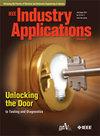IF 4.2
2区 工程技术
Q2 ENGINEERING, ELECTRICAL & ELECTRONIC
引用次数: 0
摘要
为了降低带隔离直流电源的开绕组永磁同步电机(OW-PMSM)的开关频率并增强其参数鲁棒性,本文提出了一种带有滑模观测器(SMO)的新型双矢量模型预测电流控制(DV-MPCC)方法。首先,在具有隔离直流电源的 OW-PMSM 系统中提出了 DV-MPCC,与传统的死区预测电流控制(DPCC)方法相比,该方法可将 OW-PMSM 系统的开关频率降低 50%。其次,创新性地将 SMO 应用于带隔离直流电源的 OW-PMSM 系统,该观测器可估算带隔离直流电源的 OW-PMSM 系统的定子电感、定子电阻和磁通联结失配引起的干扰。利用 Lyapunov 函数分析了观测器的稳定性。然后,结合 SMO 和 DV-MPCC,利用 SMO 观察到的扰动来修正 DV-MPCC 计算出的参考电压,从而获得更优化的开关状态和占空比。为了验证所提出的方法,我们通过仿真和实验对传统 MPCC 方法、DV-MPCC 方法和 DV-MPCC+SMO 方法进行了比较。本文章由计算机程序翻译,如有差异,请以英文原文为准。
A Robust Dual-Vector Model Predictive Current Control Scheme for Open-Winding Permanent Magnet Synchronous Motor Drives With Sliding Mode Observer
To reduce the switching frequency and enhance the parameter robustness of open-winding permanent magnet synchronous motors (OW-PMSMs) with isolated DC power sources, a novel dual-vector model predictive current control (DV-MPCC) method with sliding mode observer (SMO) is proposed. First, the DV-MPCC is presented in OW-PMSM system with isolated DC power sources, which can reduce the switching frequency of OW-PMSM system by 50% compared with the conventional deadbeat predictive current control (DPCC) method. Second, a SMO is innovatively applied to isolated OW-PMSM, which can estimate the disturbances caused by stator inductance, stator resistance, and flux linkage mismatch of OW-PMSM with isolated DC power sources. The stability of the observer is analyzed by the Lyapunov function. Then, combine the SMO and DV-MPCC, the disturbance observed by SMO is used to correct the reference voltage calculated by DV-MPCC, so as to obtain a more optimized switching state and duty cycle. To verify the proposed method, the conventional MPCC the DV-MPCC and the DV-MPCC+SMO methods are compared by simulations and experiments.
求助全文
通过发布文献求助,成功后即可免费获取论文全文。
去求助
来源期刊

IEEE Transactions on Industry Applications
工程技术-工程:电子与电气
CiteScore
9.90
自引率
9.10%
发文量
747
审稿时长
3.3 months
期刊介绍:
The scope of the IEEE Transactions on Industry Applications includes all scope items of the IEEE Industry Applications Society, that is, the advancement of the theory and practice of electrical and electronic engineering in the development, design, manufacture, and application of electrical systems, apparatus, devices, and controls to the processes and equipment of industry and commerce; the promotion of safe, reliable, and economic installations; industry leadership in energy conservation and environmental, health, and safety issues; the creation of voluntary engineering standards and recommended practices; and the professional development of its membership.
 求助内容:
求助内容: 应助结果提醒方式:
应助结果提醒方式:


